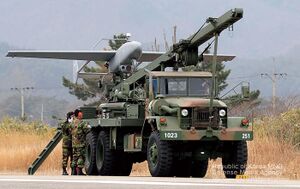Engineering:KAI RQ-101 Songgolmae
| RQ-101 Songgolmae | |
|---|---|

| |
| RQ-101 Songgolmae on a truck | |
| Role | Unmanned surveillance and reconnaissance aerial vehicle |
| National origin | South Korea |
| Manufacturer | Korea Aerospace Industries |
| Design group | Agency for Defense Development Korea Aerospace Industries |
| First flight | 1993 |
| Introduction | 2002 |
| Status | In service |
| Primary user | Republic of Korea Army |
| Produced | 2000–present |
The KAI RQ-101 Songgolmae is a South Korean military unmanned aerial vehicle (UAV) developed by the Agency for Defense Development (ADD) and the Korea Aerospace Industries (KAI) in 2000.[1][2] RQ-101 is an unarmed UAV designed for corps commanders and has been deployed and serviced by the South Korean Army since 2002 to collect military intelligence.[3][4] It was officially given the name Songgolmae (Korean: 송골매, "peregrine falcon").[2][5]
Development and Design
The South Korean Army was using Searcher UAVs, which were introduced from Israel. In 1991, South Korea began developing its own UAVs for use in ground surveillance and reconnaissance operations by Corps-level units of the South Korean Army. Exploratory development of South Korean military UAVs was carried out from 1991 to 1992, and system development began in 1993, and operational tests were conducted to verify performance until 1997, and the development was officially completed in 2000.[1][3][4] Officially, it is not known how many RQ-101s are in service with the South Korean Army. According to public sources, there were several dozen in 2017.[6]
The RQ-101 has a wingspan of 6.4 meters (21 ft) and a total length of 4.7 meters (15 ft) and is made of high-strength, light carbon fiber and glass fiber composites. The 52-horsepower (39 kW) engine accelerates the propeller-driven device to a maximum speed of 185 km (115 mi) and a cruising speed of 150 km (93 mi). The maximum altitude is about 4,500 meter (14,800 ft). The UAV can stay in the air for about six hours and cover a radius of 110 km (68 mi) to 200 km (120 mi).[1][2][3] The gross weight is 215 kg (474 lb), the maximum take-off weight is 290 kg (640 lb), and it has a payload weight of 50 kg (110 lb) for military operations.[5]
The aircraft is equipped with electro-optics (EO), forward-looking infrared (FLIR), GPS/INS navigation, and line of sight (LOS) data link for surveillance and reconnaissance and real-time target acquisition.[2][3][5][7] By default, the aircraft has an HD video camera that can send live images.[8]
Improvements
The performance improvement project was carried out from 2009 to 2011, and the hardware of the mission equipment and ground control equipment was upgraded, and three minor improvements were made until 2015. However, the RQ-101 is no longer undergoing performance improvement due to lack of additional development budget, and the Korea Aerospace Industries is currently developing a next-generation UAV named the NCUAV to replace the RQ-101 since 2012.[3][5]
Operators
 South Korea
South Korea
- Republic of Korea Army
Specifications
Data from Korea Aerospace Industries[9]
General characteristics
- Crew: Unmanned
- Length: 4.7 m (15 ft 5 in)
- Wingspan: 6.4 m (21 ft 0 in)
- Height: 1.5 m (4 ft 11 in)
- Gross weight: 215 kg (474 lb) [2]
- Max takeoff weight: 290 kg (639 lb) [2]
- Payload: 50 kg (110 lb)[5]
- Powerplant: 1 × propeller engine 52 shp (39 kW)
Performance
- Maximum speed: 185 km/h (115 mph, 100 kn) [2]
- Cruise speed: 150 km/h (93 mph, 81 kn) [2]
- Range: 200 km (120 mi, 110 nmi) [2]
- Endurance: 6 hours
- Service ceiling: 4,500 m (14,800 ft) [3]
Avionics
- SU-1K Electro-optics (EO) system[3]
- Forward-looking infrared (FLIR) camera[5]
- GPS/INS combined navigation system[7]
- Line of sight (LOS) data link[2]
References
- ↑ 1.0 1.1 1.2 Oh Dong-ryong (10 May 2022). "한국 첫 무인기 송골매 개발에서 차기 군단급 무인기 완성까지". Korea Aerospace Industries. Archived from the original on 30 December 2023. https://web.archive.org/web/20231230165807/https://www.kai-webzine.com/news/articleView.html?idxno=2906. Retrieved 30 December 2023.
- ↑ 2.0 2.1 2.2 2.3 2.4 2.5 2.6 2.7 2.8 2.9 Choi Young-jae (December 2009). "무인항공기 안전관리제도 구축 연구". Ministry of Land, Transport and Maritime Affairs. Archived from the original on 30 December 2023. https://web.archive.org/web/20231230165603/https://www.nl.go.kr/NL/onlineFileIdDownload.do?fileId=FILE-00008504202. Retrieved 30 December 2023.
- ↑ 3.0 3.1 3.2 3.3 3.4 3.5 3.6 Jaewoo Kim, Sangryul Shim (31 August 2020). "A Case Study on the Evolutionary Development of U.S Unmanned Aerial Vehicles (UAVs): Focusing on Tactical/Strategic Fixed-wing UAVs". Journal of Advances in Military Studies. Archived from the original on 29 December 2023. https://web.archive.org/web/20231229232109/https://journal.idap.re.kr/index.php/JAMS/article/download/69/53/518. Retrieved 29 December 2023.
- ↑ 4.0 4.1 "유망시장 issue report 군용드론". Korea Innovation Foundation. August 2021. Archived from the original on 30 December 2023. https://web.archive.org/web/20231230131424/https://www.innopolis.or.kr/fileDownload?titleId=178613&fileId=1&fileDownType=C¶mMenuId=MENU00999. Retrieved 30 December 2023.
- ↑ 5.0 5.1 5.2 5.3 5.4 5.5 Lee Duk-ju (28 September 2012). "상업용 민간 무인항공기 보급 기반 구축 기획 최종보고서". Ministry of Land, Transport and Maritime Affairs. Archived from the original on 30 December 2023. https://web.archive.org/web/20231230190923/https://www.kaia.re.kr/portal/cmm/fms/FileDown.do?atchFileId=FILE_000000000010443&fileSn=16&bbsId=. Retrieved 30 December 2023.
- ↑ "The Drone Index: KAI RQ-101 Night Intruder". 21st Century Asian Arms Race. 6 May 2017. Archived from the original on 30 December 2023. https://web.archive.org/web/20231230175526/https://21stcenturyasianarmsrace.com/2017/05/06/the-drone-index-kai-rq-101-night-intruder/. Retrieved 30 December 2023.
- ↑ 7.0 7.1 Bang, Ho-Gyun (7 December 2007). "Development and Verification of the Navigation Unit for UAV". Korea Aerospace Industries. Archived from the original on 30 December 2023. https://web.archive.org/web/20231230133007/https://koreascience.kr/article/CFKO200728835891305.pdf. Retrieved 30 December 2023.
- ↑ "KAI RQ-101 Night Intruder 300". AviationsMilitaires. 2023. Archived from the original on 30 December 2023. https://web.archive.org/web/20231230201459/https://aviationsmilitaires.net/v3/kb/aircraft/show/1579/kai-rq-101-night-intruder-300. Retrieved 30 December 2023.
- ↑ "Corps Level UAV (RQ-101)". Korea Aerospace Industries. Archived from the original on 30 December 2023. https://web.archive.org/web/20231230183008/https://www.koreaaero.com/EN/Business/UAV.aspx#cont01. Retrieved 30 December 2023.
 |

